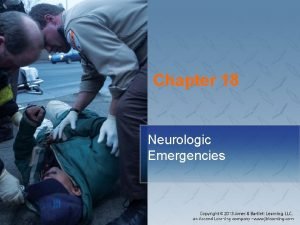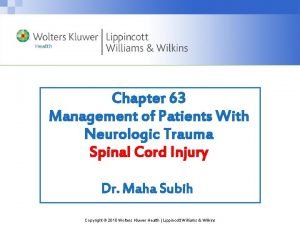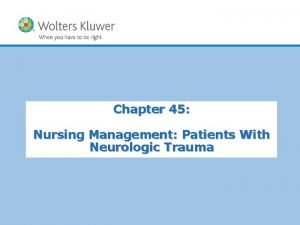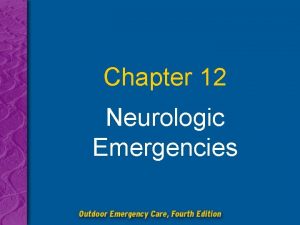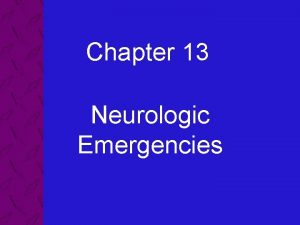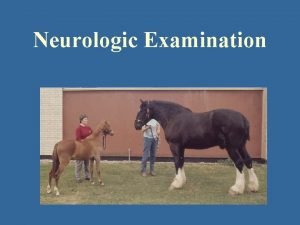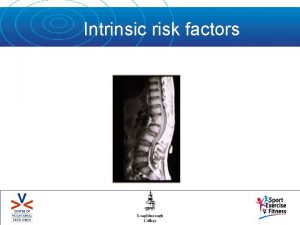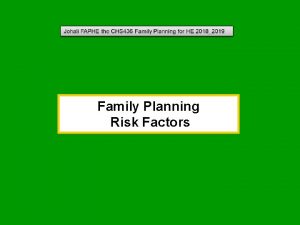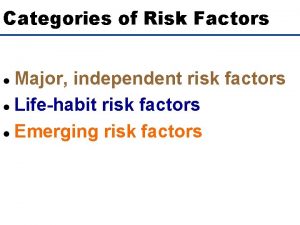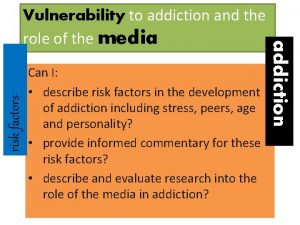Chapter 29 Neurologic Conditions Risk Factors for Neurologic


















- Slides: 18

Chapter 29 Neurologic Conditions

Risk Factors for Neurologic Disorders • Cigarette smoking • Obesity • Ineffective stress management • Elevated cholesterol • Unsafe actions • Infections of the ear or sinus • Sexually transmitted diseases

Subtle Indicators of Neurological Disease • New headaches • Change in vision • Sudden deafness; ringing in ears • Mood, personality changes • Altered level of consciousness

Subtle Indicators of Neurological Disease (cont. ) • Clumsiness; unsteady gait • Numbness and tingling of extremities • Unusual sensation of pain over nerve

Possible Factors Involved in the Development of Parkinson’s Disease • A history of metallic poisoning • Encephalitis • Cerebrovascular disease, especially arteriosclerosis • Presence of the Lewy body

Symptoms of Parkinson’s Disease • A faint tremor in the hands or feet that progresses • Muscle rigidity and weakness • Masklike appearance of face • Increased appetite • Shuffling gait

Treatment of Parkinson’s Disease • Anticholinergics • Avoidance of foods that are high in vitamin B 6 • Use of the herb passion flower • Use of pulse generators • Use of drug infusion systems • Gene therapy • Performing active and passive range-of-motion exercises

Causes of Transient Ischemic Attacks • Situations that reduce cerebral circulation – Hyperextension and flexion of the head – Reduced blood pressure resulting from anemia and certain drugs – Cigarette smoking – Sudden standing from a prone position

Manifestations of a TIA • Hemiparesis • Hemianesthesia • Aphasia • Unilateral loss of vision • Diplopia • Vertigo • Nausea; vomiting • Dysphagia

Risk Factors for Cerebrovascular Accident • Hypertension • Diabetes • Hypothyroidism • MI • TIA • Dehydration • Cigarette smoking

Warning Signs of a CVA • Light-headedness • Dizziness • Headache • Drop attack • Memory and behavioral changes

Nursing Interventions to Reduce Effect of Limitations of CVA • Talking in normal voice • Offering short explanations • Using familiar objects • Providing sensory stimulation • Offering positive feedback • Showing patience

Nursing Interventions in the Acute Phase of CVA • Maintain a patent airway. • Provide adequate nutrition and hydration. • Monitor neurologic and vital signs. • Prevent complications associated with immobility.

Nursing Interventions Following the Acute Phase of CVA • Talk to the patient during routine activities. • Briefly explain what occurred and what to expect. • Speak distinctly but do not shout. • Devise an easy means of communication. • Minimize environmental confusion, noise, traffic, and clutter. • Aim for consistency of those providing care and of care activities.

Nursing Interventions Following the Acute Phase of CVA (cont. ) • Use objects familiar to patients. • Keep a calendar or sign in the room. • Supply sensory stimulation. • Provide frequent positive feedback. • Expect and accept errors and failures.

Nursing Interventions to Promote Independence • Self-help devices • Periodic home visits by a nurse • Regular contact with a family member or friend • Daily call from a local telephone reassurance program • Continuing patience, reassurance, and encouragement

Preventing Injury to Patients Following CVA • Scrutinize the environment for unsafe conditions – Loose carpeting – Poorly lit stairwells – Clutter – Ill-functioning appliances – Lack of fire warning systems and fire escapes – Lack of tub rails and nonslip tub surfaces, and other safeguards

Source • Eliopoulos, C. (2005). Gerontological Nursing, (6 th ed. ). Philadelphia: Lippincott, Williams & Wilkins (ISBN 0 -7817 -4428 -8).
 Chapter 18 neurologic emergencies
Chapter 18 neurologic emergencies A 41 year old man presents with slow irregular breathing
A 41 year old man presents with slow irregular breathing Management of patients with neurologic trauma
Management of patients with neurologic trauma Management of patients with neurologic trauma
Management of patients with neurologic trauma Market risk credit risk operational risk
Market risk credit risk operational risk Chapter 2 risk factors behavior genes environment
Chapter 2 risk factors behavior genes environment Fspos
Fspos Typiska drag för en novell
Typiska drag för en novell Nationell inriktning för artificiell intelligens
Nationell inriktning för artificiell intelligens Ekologiskt fotavtryck
Ekologiskt fotavtryck Varför kallas perioden 1918-1939 för mellankrigstiden?
Varför kallas perioden 1918-1939 för mellankrigstiden? En lathund för arbete med kontinuitetshantering
En lathund för arbete med kontinuitetshantering Underlag för särskild löneskatt på pensionskostnader
Underlag för särskild löneskatt på pensionskostnader Tidbok yrkesförare
Tidbok yrkesförare A gastrica
A gastrica Vad är densitet
Vad är densitet Datorkunskap för nybörjare
Datorkunskap för nybörjare Stig kerman
Stig kerman Att skriva debattartikel
Att skriva debattartikel
